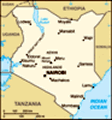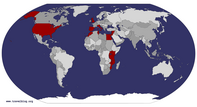Advertisement
Published: November 24th 2007
After the terrific heat of Maralal, I’m grateful for the cool, high-altitude relief of Nyahururu. My face is still smarting from a week in the sun, patches of skin flaking off like old wall paint. But as much as I’d like to enjoy this place - the bicycle taxis pedaling down the street are an especially cozy touch - Nyahururu is just a brief stop-over. In the morning I leave for Nakuru, anxious to get on with things and get back to Nairobi, where two weeks’ worth of neglected work is calling me back like a jilted lover.
Kenya’s fourth-largest city is, if anything, its unabashed champ when it comes to glue-sniffing kids. Whatever appeal Nakuru might otherwise have - its eponymous lake is one of the country’s top tourist attractions - it’s hard to get past the sight of these ragged, glassy-eyed urchins wobbling boozily down the street. They’re all skin and bones; their bare feet are filthy and cracked; there are cuts and sores on their faces. One kid approaches me on the sidewalk, swaying slightly, and asks for fifty shillings. He’s smiling goofily, like someone’s just caught him pooping in the tulips. He holds up a
plastic bottle of brandy and sloshes around the last few pulls at the bottom, as if to say “This bottle won’t fill itself, whitey!” The fact that it’s a flask of “Kenya Special Brandy” - the same brand we’d transported to Maralal in our lorry last week - just doesn’t give me the ironic glee it otherwise might.
I give the place no more time than I have to: in the afternoon I book a safari through an agency in town; by half-past six the next morning, I’m on my way to Lake Nakuru. We’ve stopped to pick up an Italian couple and a pair of young German guys who are nibbling on digestive biscuits and tittering like schoolgirls in the backseat. Joseph, our driver, steers the minivan with a strange sort of
gravitas. Now and then he’ll implore, “Is everyone okay? Is everyone okay?” with an almost breathless urgency. It takes awhile for the poor guy to loosen up, though once he gets going, he’s a particularly randy genie we’d love to shove back in the bottle, as later developments will make abundantly clear.
After more than a month in Kenya, this is my first
full-blown safari: the parade of 4WDs, the tourists in flak jackets, the hapless wildlife getting ganged up on like a chubby kid in a schoolyard. There are strange feelings being evinced here. On the one hand, as savvy readers will have by now guessed, the cynic in me - pure New-York douchebag, through and through - wants to cock an eyebrow at the whole egregious spectacle. On the other, I’m grinning like a drunk Nakuru glue-sniffer when the park’s famous flamingos come into a view: a long, pink ribbon skirting around the water’s edge. It’s the most flamboyant display I’ve seen since Jerusalem’s Gay Pride Parade. Joseph just teases us with a glimpse before barreling off toward the grasslands in the opposite direction, but already I’m anxiously fingering my camera, pointing at every waterbuck and buffalo with ferocious, childish glee.
Joseph is eagerly whetting our appetites. “Yesterday, we saw nine lions in this part of the park,” he says, gesturing with a sweep of his hand to the broad, barren savannah around us. “And we also saw two leopards.” He pauses, letting the significance of this statement sink in. Then he wheels around and parks in front of a
dozen nonplussed impala, creatures who, FYI, bear almost exactly no resemblance to either leopards or lions. That he might be setting the bar a bit too high and greasing the wheels of disappointment seems to elude Joseph. In fact, I’m getting the odd sense that he regards this as a savvy ploy - as if putting us in close verbal proximity to a leopard is every bit as thrilling as showing off the real thing.
We circle and reverse and drive off into the bush. There are clouds of ravenous mosquitoes circling the van, prompting a few agitated grabs at the bug repellent. Joseph is busily working the radio, conferring with other drivers, deciding on the best strategy. Suddenly he whirls us around a corner and slams his foot on the gas. Two leopards have been spotted by the main gate, and Joseph starts shouting “Main gate! Main gate!” into his radio, like some dogfighter in an old World War II flick. He wheels us onto the shoulder of the road and squeezes past a pair of idling matatus, but when we reach the park’s entrance three others have beaten us to the punch. Heads poke from the
tops: a half-dozen Americans with wind-tousled hair, three unflinching Japanese with brightly colored raincoats. The Americans are pointing their palm-sized digital cameras toward the bushes, where a slight rustle of leaves prompts a few
Ooohs. Suddenly a wisp of tail flashes into view, and photographic bedlam ensues. Soon we see two leopards - spotted, bewildered, muscles rippling - walk into the clearing. They take a few strides, pause, glance in our direction, disappear into a bush. This sends off a flurry of ecstatic bursts from the Americans. (“A leopard, Jimmy! Did you see that? Did you see the leopard?”) Nearby a Japanese group has unpacked a Hubble’s worth of photographic equipment onto the roof of their van. One is fidgeting with his shoulder strap and adjusting his lens - a barrel that’s so preposterously long, I can’t quite tell if he wants to take pictures of the poor things or give them a colonoscopy. Oddly, the camera is painted a colorful, cartoonish camouflage, as if the element of surprise were somehow still on our side.
Other trucks have gathered: matatus and SUVs that muscle their way along the side of the road; massive overland trucks coughing out puffs
of diesel. The tourist-to-leopard ratio at this point is roughly 87:2. And yet we’re each of us breathlessly riveted to the bush, so that by the time the pair nervously creeps out to the road, looking both ways like cautious pedestrians before crossing to the other side, I’m all but exchanging high-fives with the effeminate Germans. “Did you see that?” I want to exult. “That leopard didn’t do a thing! Not a goddamn thing!
“Yes!”
While I’m loathe to admit it, I’m soon making ticks on my mental checklist of “the Big Five”: the two loafing leopards; a pack of slightly haggard buffalo by the lake; a rhino with a little spotted bird perched on the tip of its horn. Counting the elephants I saw stomping in the distance en route to Maralal, I’ve almost wrapped up my safari grab-bag by half-past eight. We’re bumping along toward the lake for another ten minutes when Joseph slows, pointing out the window with his eyes shot wide in a sort of reverential stupor. There, laying outstretched on the long limb of a tree, a lion is swishing its tail and staring vaguely into the middle distance. Joseph kills
the engine and slowly - ever so slowly! - turns in his seat. “Lion,” he says softly, jabbing his finger once more into the air. We sit in pious silence for five minutes, watching the majestic jungle king turn its head and swing its paw and mash its little lion lips. At one point its gaze seems to fall on our car - a moment of the highest drama - and in a roaring crescendo to the morning’s events, it shifts its haunches, lays its head on an outstretched leg, and does absolutely nothing.
And so I’ve discovered the great untold secret of the African safari: most animals are really fucking lazy. Never mind the widely circulated video that’s been making the rounds on YouTube - an eight-minute free-for-all of lions, buffaloes and crocodiles doing bloody,
Discovery-channel-style battle to the death. Seen in their natural habitat - at a cost of roughly $95/day - most animals will mill in circles and snuff at piles of turds and loaf around like a bunch of teamsters. After just a couple of hours, I get the sense that the only thing keeping these guys from Death’s door is a thoughtful park ranger who circles the lake each morning, handing out chicken nuggets and boxes of Juicy Juice.
We drive along with birds dipping and swooping beside us, and baboons playing with their genitals in the trees. Joseph points to a zebra whose turgid cock is sticking out like a kickstand. “Look,” he says, extending his arm and holding it out until we all follow the direction of his finger. “That zebra has five legs."
He repeats the joke again - in fact, he’ll repeat it one by one for each of us, driving a bit closer and making sure our attention is absolutely riveted on this randy zebra. At one point, I wonder if we’ll have to get out and give the damn thing a handjob before Joseph’s satisfied. Later he drives us alongside the lake, over the hard-packed mud and the trim blades of grass. We pass a few great-winged pelicans and some storks on long, stilted legs until we reach a massive rhino, lying in the mud by its lonesome. It has stubby legs and great folds of fat cinched up around its midsection, its eyes heavy, almost drunken. It looks as old and forlorn as the women I used to see around my grandfather’s nursing home, stout and sighing and puttering around in their floral-print housedresses. Joseph points out the beast’s long, lean prick resting in the mud.
“Joseph, do you just drive around all day, looking for animal cocks?” I ask.
“Ha ha ha,” he says, adding, “ha ha ha ha ha ha.”
He parks beside the lake so we can stretch our legs. The place is blazing, bleeding pink. There are flamingos pecking at the mud and flamingos flapping their wings and flamingos making squawking noises in their slender throats. What do a million flamingos look like? Sort of like half a million flamingos, really. We spend a good fifteen minutes soaking up the gaiety, snapping pictures and shaking our heads with disbelief and exchanging little looks that say, “Sheesh!” Then Joseph packs us back into the van, wheels around in a frenzied arc, and barrels toward a flock of flamingos that scatter and lift into the air. They set the sky aflame - a commotion of bright plumage and jackknifing wings - before settling back onto the lake's shore, beside the feathers, bones, and piles of bird shit.
Advertisement
Tot: 0.117s; Tpl: 0.012s; cc: 12; qc: 29; dbt: 0.047s; 1; m:domysql w:travelblog (10.17.0.13); sld: 1;
; mem: 1.1mb











